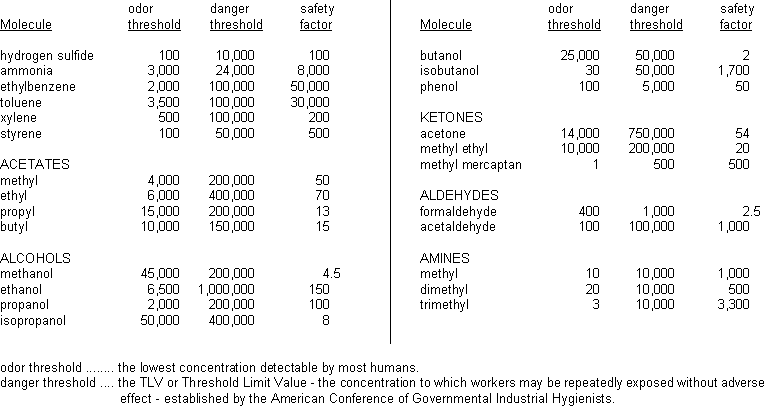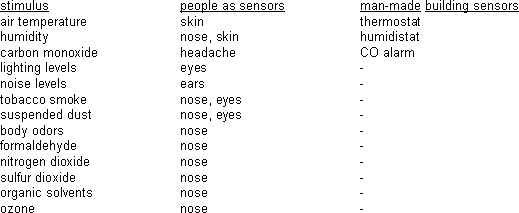|
|
People, the Best Air-Quality MonitorsTo date, improving IAQ has been mysterious, expensive or impossible. Management hasn’t welcomed sensitive noses complaining of unpleasant building odors. Now, with the advent of Gray Matter® media and air filters, noses in virtually any building are satisfied.
The Unique Sense, Smell
We perceive the world by way of five inputs: seeing, hearing, touching, tasting and smelling. Smell is unique in that it is the sense which is always open to stimulation. Wherever we are we may close our eyes, plug our ears, touch and taste nothing, but we must breathe, and, in drawing in air, we stimulate the base of our brains.
Smelling is a complex operation. As we inhale, airborne molecules are drawn to a patch of nerve cells, the olfactory neurons, perched in the warm, moist recesses of the upper nose. These neurons with fine, hair-like cilia sway in the incoming air. They contain many types of molecule-specific receptors which trap molecules and pass information to the neurons which send signals to the olfactory bulbs on the underside of the brain. The olfactory bulbs then relay the odor signals to parts of the higher brain which interpret the signals.
The receptors on the cilia, which snag odorant molecules and tell the brain what is being smelled, have recently been identified and researchers have discovered the genes responsible for producing them. In the process of their research they discovered nearly 1,000 genes dedicated to the sense of smell. The reason there are so many is seated in human evolution.
Evolution of the Sense
Millions of years ago, in dense jungles and on open savannas, pre-humans eked out a bare existence. In small clans they gathered food, tended their families and tried to stay out of harm's way by using all five senses. Often, staying alive meant being able to smell danger. The natural environment was loaded with odor information, some important to survival and some merely interesting. A good nose and the ability to interpret smells correctly was important. Sexually-alluring musk, fresh meat, and fragrant fruit only smell "alluring", "fresh" and "fragrant" because those of our ancestors who found them attractive found food, ate better, lived longer and bore offspring. Conversely, ancient relatives who could not smell the difference between a fresh cut from a new kill and putrid boar ribs, died of food poisoning at an early age with no progeny. In this way, by natural selection, through individual mistakes and successes, human noses and brains, gradually became more acute. The variety of "olfactants", the molecules we can smell, is near 10,000 - some at surprisingly low concentrations.
Notice how much more sensitive we are to "ancient odors" - those molecules which our species adapted to over many generations of evolution. All were present in minute concentrations and all were related to survival - predators, reproduction, and food. It follows then that we are far less sensitive to "modern odors" - man-made molecules which may be very dangerous, but were not present as we evolved. For example, we are a million times more sensitive to musk than chlorine and one hundred thousand times more sensitive to rancid meat than phosgene. None-the-less, our noses are sufficiently sensitive to warn us of modern dangers.Smell, an Excellent Early-Warning System
We are able to smell most man-made molecules at concentrations (odor thresholds) much more dilute than those which will harm us (danger thresholds). The table below lists both for a number of common molecules (concentrations are in ppb). The ratio of dt/ot is the safety factor. Our sensitive noses easily warn us of most types of "bad air".

We Can't Walk Away, So Let's Clean It Up
Ironically, modern technology created the indoor air quality problem. Outdoor air infiltration and high rates of outside air make-up were acceptable when energy was relatively cheap. Energy became more expensive in the early 1970's and architects and engineers responded with designs for tightly-sealed, energy-efficient buildings. Existing structures were sealed to reduce loss of expensive heated or cooled indoor air. Indoor air was recirculated and kept indoors much longer than before. Unfortunately, saved energy was not the only result of these measures. An unexpected consequence of tighter building construction is that indoor sources have become major contributors to indoor air pollution. Concentrations of gases given off indoors by indoor sources increase to harmful levels as the same air is recirculated. A new series of health problems has been created. Terms, such as Indoor Air Quality (IAQ) and Sick Building Syndrome (SBS) have been coined - necessary new additions to our parlance.
People, the Best Sensors
Air temperature and humidity are usually maintained automatically by the use of sensors which control air conditioning, but other characteristics such as light and noise levels and air quality are maintained without automatic feedback control. In fact occupants are the only effective "sensors" for most of the conditions in the building. It is important to recognize, respect and welcome the role of occupants as sensors.Here are some ways in which people are superior to man-made sensors:

Also, people are sensitive to more stimuli than man-made sensors:
